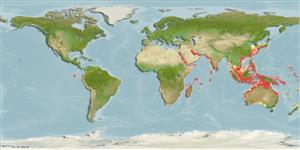>
Tetraodontiformes (Puffers and filefishes) >
Diodontidae (Porcupinefishes (burrfishes))
Etymology: Cyclichthys: Greek, kyklos = round + Greek, ichthys = fish (Ref. 45335).
More on authors: Leis & Randall.
Environment: milieu / climate zone / depth range / distribution range
Ecologia
marino associati a barriera corallina; distribuzione batimetrica 3 - 90 m (Ref. 30573). Tropical
Indo-West Pacific: Red Sea to South Africa and east to southern Japan, the Philippines, Australia and New Caledonia (Ref. 9680). Eastern Pacific: Galapagos Islands (Ref. 5227). Mediterranean: Israel (Ref. 43448).
Size / Peso / Age
Maturity: Lm ? range ? - ? cm
Max length : 34.0 cm TL maschio/sesso non determinato; (Ref. 9710)
Spine dorsali (totale) : 0; Raggi dorsali molli (totale) : 11 - 13; Spine anali: 0; Raggi anali molli: 10 - 12. Fins unspotted; adults with black spots on sides and belly, the spots associated with spine bases; no spines on caudal peduncle (Ref. 4423).
Found in coastal waters in the vicinity of reefs (Ref. 9680). Lives in seagrass habitats and coastal slopes with sponges. Active during the night (Ref. 48637). Nocturnal and solitary (Ref. 9680), usually found under ledges during the day (Ref. 9710). Juveniles pelagic (Ref. 30573). Feeds on hard-shelled invertebrates (Ref. 9680). Not usually marketed (Ref. 9680).
Life cycle and mating behavior
Maturities | Riproduzione | Spawnings | Egg(s) | Fecundities | Larve
Leis, J.M., 1986. Diodontidae. p. 903-907. In M.M. Smith and P.C. Heemstra (eds.) Smiths' sea fishes. Springer-Verlag, Berlin. (Ref. 4423)
IUCN Red List Status (Ref. 130435)
Threat to humans
Harmless
Human uses
Pesca: di nessun interesse
Strumenti
Special reports
Download XML
Fonti Internet
Estimates based on models
Preferred temperature (Ref.
123201): 22.1 - 29, mean 27.8 °C (based on 1622 cells).
Phylogenetic diversity index (Ref.
82804): PD
50 = 0.6250 [Uniqueness, from 0.5 = low to 2.0 = high].
Bayesian length-weight: a=0.04786 (0.01967 - 0.11644), b=2.82 (2.61 - 3.03), in cm total length, based on LWR estimates for this (Sub)family-body shape (Ref.
93245).
Trophic level (Ref.
69278): 3.5 ±0.41 se; based on food items.
Resilienza (Ref.
120179): Medio, tempo minimo di raddoppiamento della popolazione 1.4 - 4.4 anni (Preliminary K or Fecundity.).
Fishing Vulnerability (Ref.
59153): Low vulnerability (24 of 100).
Nutrients (Ref.
124155): Calcium = 41.9 [18.0, 102.3] mg/100g; Iron = 0.616 [0.314, 1.379] mg/100g; Protein = 18.3 [16.1, 20.5] %; Omega3 = 0.12 [0.06, 0.23] g/100g; Selenium = 42.6 [21.9, 87.4] μg/100g; VitaminA = 48 [14, 172] μg/100g; Zinc = 1.05 [0.72, 1.56] mg/100g (wet weight);
